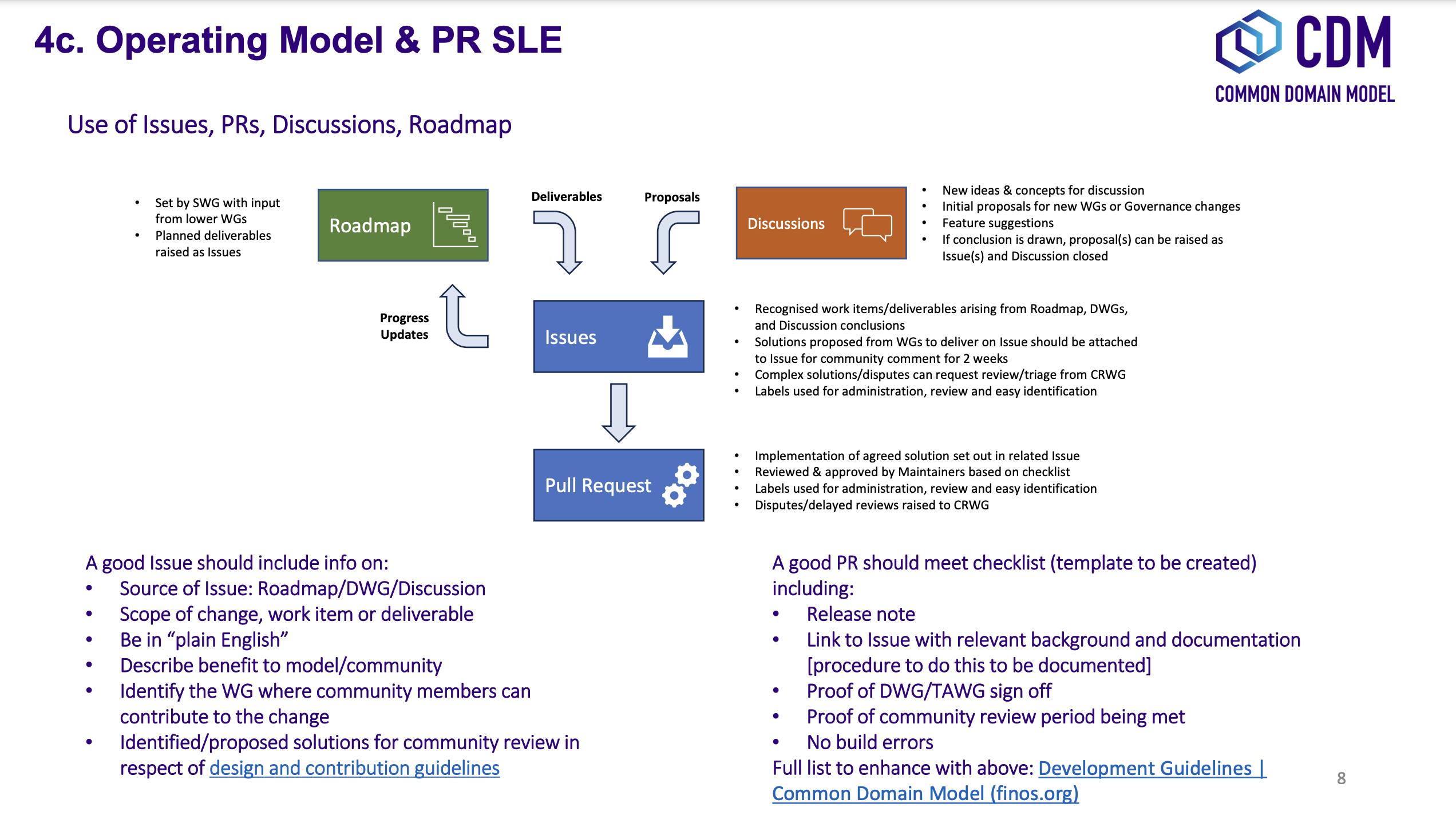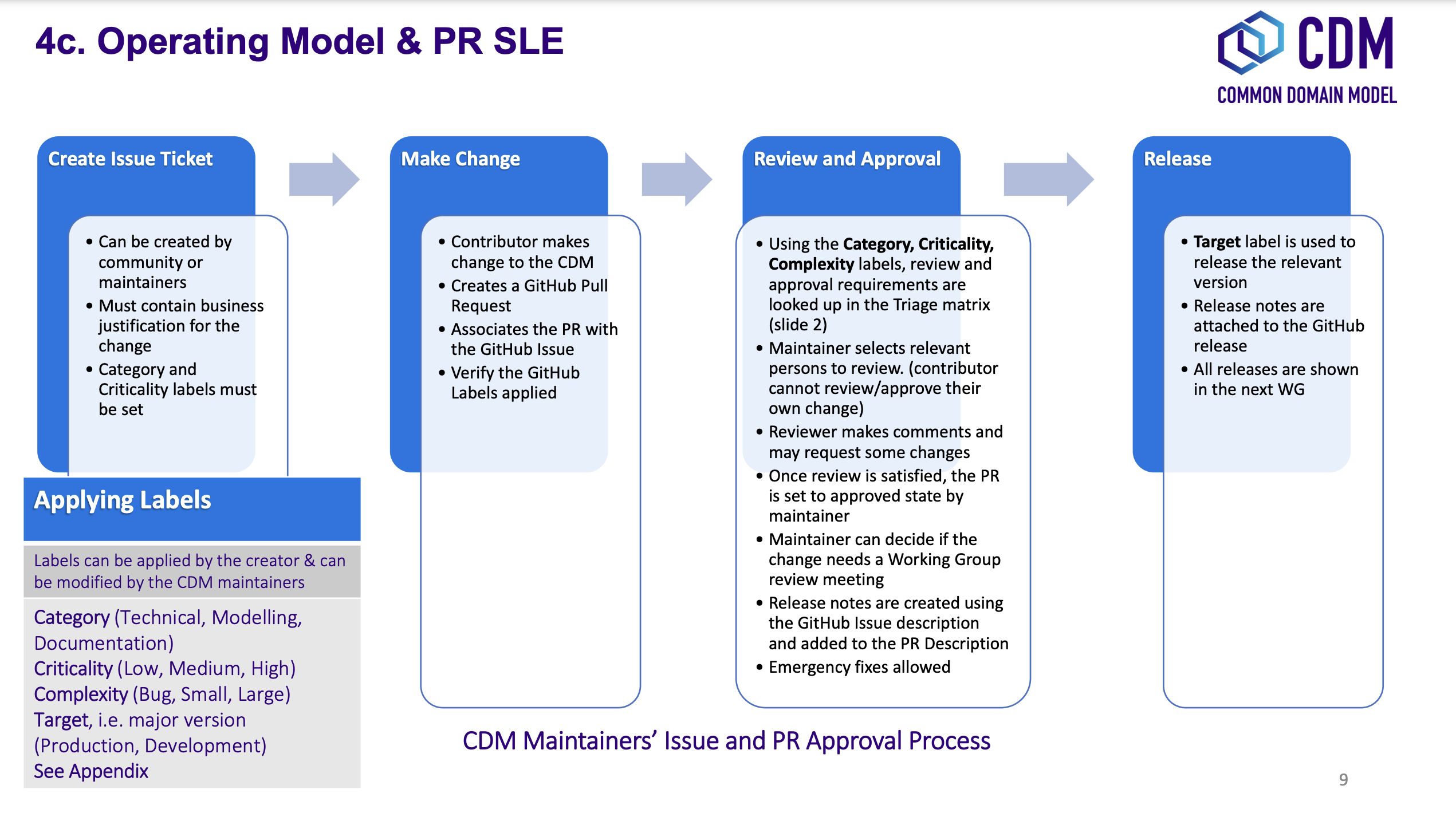Editing the Model
Editing the model
When editing the CDM, please go through the following modelling checklist:
- CDM version: use the latest available development version
- Syntax: no syntax warnings or errors
- Compilation: model compiles ok with no static compilation errors
- Testing: all translate regression tests expectations for mapping, validation and qualification maintained or improved. Additional test samples may be needed if use-case is not covered by existing samples.
- Namespace: all model components positioned in the correct namespace
- Descriptions: all model components have descriptions
The following sections detail that checklist. When using the Rosetta Design web application to edit the model, the Contributor should also refer to the Rosetta Design Guide.
CDM version
To the extent possible it is recommended that the Contributor keeps working with a version of the CDM that is as close as possible to the latest to minimise the risk of backward compatibility.
Please refer to the Source Control Integration Guide for more information.
Syntax
The model is represented in the Rosetta DSL syntax. All syntax warnings and errors must be resolved to have a valid model before contributing any changes. For further guidance about features of the syntax, please refer to the Rosetta DSL Documentation.
In Rosetta Design, that syntax is automatically checked live as the user edits the model, as described in the Rosetta Design Content Assist Guide.
Compilation
Normally, once the model is syntactically correctly edited, valid code is being auto-generated and compiled. However, certain model changes can cause compilation errors when changes conflict with static code (e.g. certain mapper implementations).
The Rosetta support team can help resolve these errors before the changes are contributed. In most cases you will be able to contact the team via the In-App chat. If the support team identifies that significant work may be required to resolve these errors, they will notify the Contributor who should then contact the CDM Maintainer originally appointed for the proposed change and/or CDM Owners. The latter will be able to assist in the resolution of the issues.
For more information about auto-compilation using the Rosetta DSL, please refer to the Rosetta Auto Compilation Guide.
Testing
The CDM has adopted a test-driven development approach that maps model
components to existing sample data (e.g., FpML documents or other
existing standards). Mappings are specified in the CDM using synonym
which are collected into a Translation Dictionary, and the sample data
are collected into a Test Pack. Each new model version is
regression-tested using those mappings to translate the sample data in
the Test Pack and then comparing against the expected number of mapped
data points, validation and qualification results.
When using Rosetta to edit the model, contributors are invited to test their model changes live against the Test Pack using the Rosetta Translate application, referring to the Rosetta Translate Guide. When editing existing model components, the corresponding synonyms should be updated to maintain or improve existing mapping levels. When adding new model components, new sample data and corresponding synonym mappings should also be provided so the new use-case can be added to the set of regression tests.
Please refer to the Mapping Guide for details about the synonym mapping syntax.
Namespace
All model components should be positioned appropriately in the existing namespace hierarchy. If the proposed contribution includes changes to the namespace hierarchy, those changes should be justified and documented. Any new namespace should have an associated description, and be imported where required.
Please refer to the namespace documentation section for more details.
Descriptions
All model components (e.g. types, attributes, conditions, functions etc.) should be specified with descriptions in accordance with the CDM Documentation Style Guide.
Contributing model changes
Contribution checklist
Before you start contributing your model changes, please go through the following contribution checklist:
- Specify a meaningful title and description for the contribution
- Notify the CDM Maintainers (via email or Slack) of the submitted contribution
- Include:
- Any notes on expected mapping, validation or qualification changes (success numbers should not decrease)
- Additional data samples, if necessary
- Documentation adjustment, if necessary
- Release notes
- Any other additional materials or documentation that may help with the review and approval process
Note: A contribution should be a whole releasable unit and its size calibrated in accordance with the CDM's agile development approach.
Contributing
Changes are contributed by submitting a Pull Request for review into the CDM source-control repository. This pull request will invoke a build process to compile and run all CDM unit tests and regression tests.
Given the alignment:
1 pull request = 1 contribution = 1 releasable unit = 1 user story,
we recommend labelling the pull request with the user story label, i.e. "STORY-XYZ: ..." to facilitate its tracking.


Note: All contributions are submitted as candidate changes to be incorporated under the CDM licence.
When using Rosetta to contribute model changes, the contribution interface allows to specify a title and description for the contribution. Those inputs are used to create a Pull Request on a one-off branch in the source-control repository. Please refer to the Rosetta Workspace Contribution Guide for more information.
Note: It is not yet possible to contribute updated test expectations, documentation, release notes or new sample data using Rosetta, so these must be provided to the CDM Maintainers via Slack or email.
Documentation
The CDM documentation must be kept up-to-date with the model in production. Where applicable, the Contributor should provide accompanying documentation (in text format) that can be added to the CDM documentation for their proposed changes.
The documentation includes code snippets that directly illustrate explanations about certain model components, and those snippets are validated against the actual model definitions. When a model change impacts those snippets, or if new relevant snippets should be added to support the documentation, those snippets should be provided together with the documentation update.
Release note
A release note should be provided with the proposed model change that concisely describes the high-level conceptual design, model changes and how to review. Please refer to the content of release notes for further guidance on editing release notes.
Reviewing model changes
Review checklist
Before starting to review a contribution, the CDM Maintainer should go through the review checklist.
Note: It is not yet possible to verify that mapping, validation and qualification expectations have been maintained by looking at the output of the Pull Request and CDM build only. Please refer to the downstream dependencies section for more details.
- CDM build process completed with no errors or test failures
- Review additional samples provided (if use-case is not covered by existing samples)
- All model components positioned in the correct namespace
- All model components have descriptions
- Additional documentation provided, if necessary.
- Release note provided
Any review feedback should be sent to the Contributor as required via Slack, email or in direct meetings.
Note: Depending on the size, complexity or impact of a contribution, the CDM Maintainer can recommend for the contribution to be presented with an appropriate level of details with the CDM Architecture and Review Committee for further feedback. The CDM Maintainer will work with the Contributor to orchestrate that additional step. The additional feedback may recommend revisions to the proposed changes. When it is the case the review process will iterate on the revised proposal.